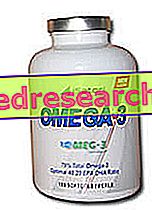By Dr. Nicola Sacchi - Author of the book: Drugs and doping in sport -
See also: why aerobic training is counter-productive; heart rate for weight loss
Do you think that the best way to lose weight is to do aerobic activity? If so, you are mistaken, as several studies show that high intensity training is more effective than aerobic activity in promoting weight loss.

This article will show some of these searches.
First of all, to fully understand these studies we need to correctly define what aerobic activity and high intensity activity are.
- By aerobic exercise is meant a motor activity performed at modest cardio-circulatory effort, with constant intensity and such as to allow this effort to be prolonged for several minutes. To be aerobic, an exercise must allow the body to use oxygen to produce energy. When the intensity of the effort rises too much, the quantity of oxygen available is no longer sufficient, and the body uses so-called anaerobic systems to produce additional energy, increasing the production of lactate. To consider an aerobic exercise it is necessary to measure its intensity and to evaluate precisely that the body does not accumulate lactic acid. This measurement can be performed using several more or less precise techniques, although clearly the direct measurement of the blood lactate concentration is the most precise. In practice, as in the gym, however, the heart rate is used as a reference. Therefore, to quantify this intensity of effort it is used to calculate the anaerobic threshold heart rate, beyond which the body can no longer produce sufficient energy by exploiting only the oxidative pathways. This frequency is usually considered to be about 85% of the maximum heart rate; this assumption has a certain margin of error, but in the studies used the reference is considered to separate aerobic training from high intensity training. Therefore, for aerobic activity, it is considered that performed below this heart rate.
For more details on this definition you can consult other pages on this site.
- The high intensity activity can be developed in various ways, for example by using muscle exercises. In this case we consider such an exercise that brings the heart rate above the lactate threshold, given that the studies examined use this parameter to define the training protocol itself as high intensity. This type of work is commonly called High Intensity Interval Training (HIIT) or High Intensity Interval. Personally, I consider the term "interval" superfluous, given that as this activity is strictly anaerobic it cannot be supported by the body for prolonged periods; it is therefore inevitable that less intense intensity activities be alternated with it, to guarantee the continuity of the exercise itself; therefore, the recovery interval is a necessary condition to continue the training and, as such, is superfluous in the definition of the type of training. For this reason it will be called simply high intensity training.
I would also add that these researches are all published in authoritative scientific journals and have therefore been conducted with absolute rigor.
I study
Tjønna and colleagues, who study the metabolic syndrome, conducted this experiment to test various biochemical effects of two different physical activity protocols. The first includes four periods of 4 minutes of activity at 90% of the maximum HR, interspersed with 3 minutes of recovery at 70% of HR max; the second protocol instead foresees a constant activity at 70% of the HR max, for a period that leads to the same calorie consumption as the first group. These workouts are performed on the treadmill 3 times a week for 16 weeks.
At the end of the study, various parameters are measured, including the FATP-1 and FAS enzymes, which in short are lipogenic enzymes present in adipocytes (fat cells) responsible for the deposition of new adipose tissue. The result is that the high intensity training protocol further reduces the presence of these enzymes in fat cells.
II study
Trapp and colleagues directly studied the effects on fat loss of two different training protocols. The first, at high intensity, included sprints of 8 seconds followed by 12 seconds of recovery, for a maximum of 20 minutes, while the second involved pedaling at a constant speed, keeping the frequency close to 60% of the max FC, for a maximum 40 minutes of training. Note that also in this case the duration of aerobic training was definitely longer in terms of time than the high intensity one.
Among the various results obtained with this study there is also the measurement of fat loss after 15 weeks of training: once again, the group trained with high intensity gets a fat loss significantly higher than the other. There are many other interesting facts in this study, but in order not to become too distracting I prefer not to talk about it.
SECOND PART "



